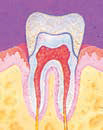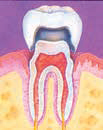Why Is A Crown & Bridge Treatment Necessary?
Losing a permanent tooth – whether it be due to dental decay, periodontal (gum) disease, injury or accident – can cause many serious problems for your neighbouring teeth. Because the support and chewing forces are altered, the remaining teeth may begin to shift.
The opposing tooth above or below the lost tooth can begin to move up or down and out of the socket, which can accelerate periodontal disease and further break down the bone structure. If the missing tooth is not replaced, more teeth may eventually be lost due to the improper forces exerted during chewing.
Your Patient Guide
Crown Bridge
How Is This Treatment Performed?
Once we determine that crown and bridge treatment is indicated, a series of appointments will be scheduled for you. It is important for you to keep all of these appointments to prevent any delays in treatment. At the first appointment, we complete a thorough oral examination, including an evaluation of your dental history. Any necessary X-Rays are completed at this time.
During the restorative procedure, we first anesthetize the area to be treated. Next, we carefully shape and contour the tooth or teeth to be crowned to allow the crown or bridge sufficient space for proper fit and appearance. Finally, we make an impression of the area and fit the teeth involved with a temporary crown or bridge to protect them until your next appointment.
At the following appointment, we evaluate the final crown or bridge for proper fit before placing it permanently, making final adjustments, if necessary. Other factors we carefully consider at this time include: Esthetics, Function and Tissue Compatibility.
Caring For Your Crown & Bridge
Care for it as you would any of your other teeth you wish to preserve! Proper oral hygiene, including flossing and brushing is just as important in helping you keep your teeth and gums healthy.
We recommend avoiding sticky foods, gum, taffy and crunchy foods, such as hard candy. Remember, no ice cubes!
The Benefits Of Crown And Bridge Treatment
Crown and bridge treatment reverses the negative impact of missing teeth in a variety of ways:
- Restores and maintains the natural bite
- Prevents unnatural stress on fiher teeth
- Keeps opposing teeth in their proper place
- Prevents shifting and tilting of adjacent teeth
- Discourages further dental decay and gum disease
- Enhances your smile, speech and chewing function

Your teeth will be fitted with provisional coverage until your next appointment

The new cap is adjusted and permanently cemented
Did You Know?
If you are faced with tooth loss, crown and bridge treatment may be the right restorative option for you! Restore lost teeth, while supporting your natural teeth and promoting good dental health.
What Is A Crown?
A crown – sometimes called a “cap” – is a tooth-like covering placed over a carefully prepared existing tooth. Used to strengthen, restore or improve the appearance of your natural tooth, a crown is placed on an individual tooth much like a thimble over your finger.
Crowns serve many functions in addition to being used to strengthen a tooth to accommodate the attachment of a fixed bridge. One of the most common types of crown supports the tooth when there is no longer sufficient tooth structure left to place a filling.
Crowns may also be used to protect the structure of a tooth that is fractured or broken.

Crowned Teeth
What Is A Bridge And Why Are Crowns Involved?
A bridge is a custom device anchored to neighbouring teeth that replaces one or more missing teeth. When a lost tooth is replaced with bridge-work, the teeth on either side of the missing one must be prepared as crowns to serve as anchors to hold the replacement teeth in place.
Crowns and bridges are most often made from superior materials such as semi-precious or precious metals, porcelain or a combination of metal fused to porcelain. Both appearance and function are considered when selecting the material most suitable for you.

A full compliment of teeth

The result of lost teeth
What Our Patients Say?
We accept all major insurance plans.
We accept a number of insurance plans to help cover the cost depending on your individual needs.
